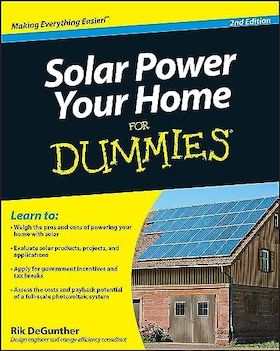
-----
Black Chromium
I want to know about Black chromium and barium sulphate that use for electroplating (Black Chromium) in solar technology, regarding the chemical properties, atomic properties, mechanical properties and other related. I also want to know why they usually use Black Chromium compared to other material such as Black Nickel.
Mohd Nazri Bin Sharum- Johor Baharu, Johor, Malaysia
Barium sulphate is only very slightly soluble, so you won't be adding much of this material. Where did you hear of this material for use in chromium plating?

Tom Pullizzi
Falls Township, Pennsylvania
This is a small part of a research paper I wrote last term about solar hot water heaters. I did extensive research is this is just a little of what I found.
Selective Surfaces
The next item for discussion is the absorber plate more commonly known as a selective surface. The selective surface has similar qualities to the hot seat belt in your car that was mention earlier. The selective surface absorbs the sun's radiation producing elevated temperatures. The book Solar Engineering of Thermal Processes states that the temperature of this surface, selective surface, in most flat-plate collectors is less than 200 °C. There are many different types of selective surfaces available today bearing a range of qualities.
The materials used as selective surfaces vary from the inexpensive steel or aluminum plate that can be spray painted black to the high tech and costly black chromium nickel plated copper panel. The spray painted metal cost less than black chromium but has a much lower efficiency and will deteriorate faster. The black chromium is very durable, highly resistant to humid or oxidizing atmospheres and extreme temperatures while being able to retain it's selective properties. Depending on the individual's needs and financial resources discretion is advised when choosing a selective surface.
All selective surfaces need to be able to absorb high amounts of radiation. Absorbed radiation is referred to as alpha. To be able to retain the radiation the surface must have a low emission rate known as epsilon. Having a higher alpha and a lower epsilon makes the selective surface and encompassing conversion system more efficient. With this in mind these qualities allow for a greater quantity of hot water to be produced in a shorter amount of time. Some selective surfaces have a high alpha and epsilon. This means that they absorb high quantities of radiation but reflect the radiation. It is the same as wearing a white shirt opposed to a black one. They both are shined upon by the same amount of sun light but the white shirt reflects more light and keeps you cooler than the black shirt.
Selective Surfaces and Efficiency
To start one selective surface used in solar collectors is nickel black on galvanized steel. Selective properties of this surface include an alpha of 0.81 and an epsilon of 0.17. Notice that the alpha is greater than the epsilon (Alpha>Epsilon ) giving this surface a fair efficiency. To attain an even higher alpha black copper on copper panel can be used to attain an alpha of 0.89 with the same epsilon of 0.17. The copper panel is treated with sodium hydroxide
[affil link] (NaOH) and sodium chlorite (NaClO2) to get the higher alpha.
Copper panel could be treated with Ebonol carbon to give it a chemical coating largely of copper monoxide (CO). By applying this process the alpha is increased to 0.90 and the epsilon is decreased to 0.16. This dose not enhance the selective properties by much so to pay a considerable higher cost would not be applying the Engineering Method (common sense) discussed in our engineering class.
A patterned cermet coating on steel has an alpha of 0.96 and epsilon of 0.16. According to Haley's Condensed Chemical Dictionary cermit is defined as a semi synthetic product consisting of mixture of ceramic and metallic components having physical properties not found solely in either one alone. This combination is useful because metal is highly conductive and ceramics are durable and retain heat well.
The last selective surface we will discuss is black chromium nickel-plated copper. This selective surface I recommend using in a solar flat-plate collector because of its resistance to corrosion and low maintenance requirements. Black chromium's alpha is 0.97 and epsilon between 0.10 and 0.12. This material is not inexpensive and is difficult to attain. The market is small in the US and most is sold abroad. A home brew is possible but requires the use of highly toxic chemicals such as nickel vapor and extremely corrosive sulfuric acid.
I hope this is of some help. I found a lot of good information in the book
Solar Engineering of Thermal Processes
[on
Amazon affil links] by John A. Duffie & William A. Beckman,1991 by John Wiley and Sons, Inc.
first year engineering student - Bend, Oregon
I like knowing what are the best surface treatments on the absorbing plate (copper, aluminum or steel) for the best solar radiation absorption.
Thanks.
- Asturias, Spain
Dear Sirs,
I am searching for more detailed literature about the technique of plating copper foil with black chrome over nickel layer ... Can someone help me about the required plating systems and the layer thickness required ?
Thanks !
- Cairo, Egypt
Why industry uses Black chromium plating ? what is difference on another plating?
And I want to know about Black chromium plating process .
student - Bangkok, Thailand
June 24, 2009
Hi,Prapha. Please tell us your situation so that we can understand in what respects the previous replies did not fulfill your needs. Thanks.
Regards,

Ted Mooney, P.E.
Striving to live Aloha
finishing.com - Pine Beach, New Jersey
Ted is available for instant help
or longer-term assistance.
June 26, 2009
Q, A, or Comment on THIS thread -or- Start a NEW Thread
